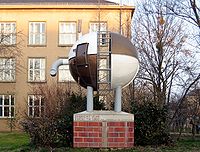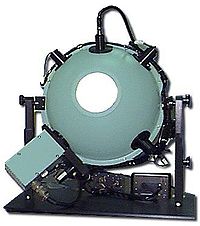
Integrating sphere
Encyclopedia

Diffuse reflection
Diffuse reflection is the reflection of light from a surface such that an incident ray is reflected at many angles rather than at just one angle as in the case of specular reflection...
reflectivity
Reflectivity
In optics and photometry, reflectivity is the fraction of incident radiation reflected by a surface. In general it must be treated as a directional property that is a function of the reflected direction, the incident direction, and the incident wavelength...
(i.e., white), having relatively small holes as needed for entrance and exit ports.
The shape of the cavity is commonly spherical, hence the name.
Its relevant property is a uniform scattering
Scattering
Scattering is a general physical process where some forms of radiation, such as light, sound, or moving particles, are forced to deviate from a straight trajectory by one or more localized non-uniformities in the medium through which they pass. In conventional use, this also includes deviation of...
or diffusing effect.
Light rays incident on any point on the inner surface are, by multiple scattering reflections, distributed equally to all other such points and effects of the original direction of such light are minimized.
An integrating sphere may be thought of as a diffuser which preserves power but destroys spatial information.
It is typically used with some light source and a detector for optical power measurement.
Applications

Photometry (optics)
Photometry is the science of the measurement of light, in terms of its perceived brightness to the human eye. It is distinct from radiometry, which is the science of measurement of radiant energy in terms of absolute power; rather, in photometry, the radiant power at each wavelength is weighted by...
or radiometric measurements, such as:
- quantifying the total of the light radiated in all directions from a lamp,
- measuring diffuse reflectance of surfaces, while properly averaging over all angles of illumination and observation,
- creating a light source with apparent intensity uniform over all positions within its circular aperture, and independent of direction except for the cosine function inherent to ideally diffuse radiating surfaces (Lambertian surfaces).
- accurately measuring the sum of all the ambient light incident on a small circular aperture.
- measuring the power in laser beam, with best available independence of beam details such as beam shape, incident direction, and incident position.

